Themed collection Supramolecular Chemistry in Water

Editorial: Supramolecular chemistry in water
This themed collection highlights some of the exciting research in supramolecular chemistry in water.

Org. Biomol. Chem., 2015,13, 2499-2500
https://doi.org/10.1039/C5OB90026C
Corrin-based chemosensors for the ASSURED detection of endogenous cyanide
Cassava (Manihot esculenta Crantz) is a staple food for more than 500 million people, especially in Africa and South America.
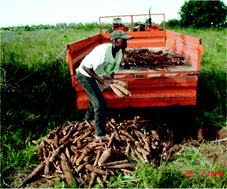
Org. Biomol. Chem., 2015,13, 14-17
https://doi.org/10.1039/C4OB01889C
Bistren cryptands and cryptates: versatile receptors for anion inclusion and recognition in water
Bistren cryptands can act as selective anion receptors in water in two distinct versions: as hexaprotonated cages and as dicopper(II) cryptates. Both classes of receptors exert geometrical selectivity, but dimetallic cryptates establish the strongest interactions with the anion.
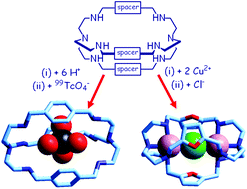
Org. Biomol. Chem., 2015,13, 3510-3524
https://doi.org/10.1039/C4OB02618G
Supramolecular control of transition metal complexes in water by a hydrophobic cavity: a bio-inspired strategy
Different strategies for obtaining water-soluble cavity-appended metal complexes are described, and their resulting interlocked assets are discussed in relationship with the very specific properties of water as a solvent.
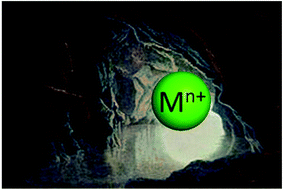
Org. Biomol. Chem., 2015,13, 2849-2865
https://doi.org/10.1039/C4OB02511C
Cucurbituril-based supramolecular engineered nanostructured materials
Nanostructured materials, including nanoparticles, nanocomposites, vesicles, and rods, have been prepared by taking advantage of the interesting features of cucurbituril homologues.
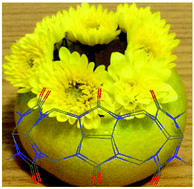
Org. Biomol. Chem., 2015,13, 330-347
https://doi.org/10.1039/C4OB02065K
Synthesis and evaluation of a boronate-tagged 1,8-naphthalimide probe for fluoride recognition
A biocompatible fluoride receptor has been developed where the interaction between the boronic acid ester and amine (NH) results in fluoride ion selectivity and enhanced fluorescence quenching.
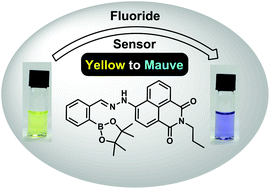
Org. Biomol. Chem., 2015,13, 4143-4148
https://doi.org/10.1039/C4OB02267J
The first water-soluble bowl complex: molecular recognition of acetate by the biomimetic tris(imidazole) Zn(II) system at pH 7.4
The bowl-shaped cavity-ligand based on resorcinarene has been successfully transposed into a water-soluble version that readily binds Zn(II) and acetate at physiological pH.

Org. Biomol. Chem., 2015,13, 3194-3197
https://doi.org/10.1039/C4OB02514H
Cucurbiturils as supramolecular inhibitors of DNA restriction by type II endonucleases
Cucurbiturils inactivate the restriction reaction of type II endonucleases via supramolecular interactions. This was monitored for different enzyme–DNA combinations in the absence and presence of organic macrocycles. The process can be re-activated by competitive displacement on addition of polyamines.

Org. Biomol. Chem., 2015,13, 2866-2869
https://doi.org/10.1039/C4OB02122C
Tuning viscoelastic properties of supramolecular peptide gels via dynamic covalent crosslinking
A dynamic covalent crosslinking approach is used to crosslink supramolecular peptide gels.

Org. Biomol. Chem., 2015,13, 1983-1987
https://doi.org/10.1039/C4OB02217C
A short, rigid linker between pyrene and guanidiniocarbonyl-pyrrole induced a new set of spectroscopic responses to the ds-DNA secondary structure
A DNA-targeting dye exhibited pH-dependent selectivity toward AT-DNA (pH 7) or GC-DNA (pH 5), accompanied by fluorimetric (pH 5) and ICD (pH 7) recognition.
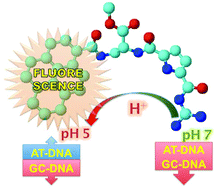
Org. Biomol. Chem., 2015,13, 1629-1633
https://doi.org/10.1039/C4OB02169J
Highly selective and sensitive detection of glutathione using mesoporous silica nanoparticles capped with disulfide-containing oligo(ethylene glycol) chains
Mesoporous silica nanoparticles loaded with safranin O and capped with disulfide-containing oligo(ethylene glycol) chains were used for the selective and sensitive fluorimetric detection of GSH.
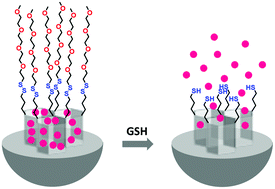
Org. Biomol. Chem., 2015,13, 1017-1021
https://doi.org/10.1039/C4OB02083A
Anion binding by biotin[6]uril in water
We show that the newly discovered 6 + 6 biotin-formaldehyde macrocycle Biotin[6]uril binds a variety of anionic guest molecules in water. We discuss how and why the anions are bound based on data obtained using NMR spectroscopy, mass spectrometry, isothermal titrations calorimetry (ITC), computational calculations and single crystal X-ray crystallography.
![Graphical abstract: Anion binding by biotin[6]uril in water](/en/Image/Get?imageInfo.ImageType=GA&imageInfo.ImageIdentifier.ManuscriptID=C4OB02211D&imageInfo.ImageIdentifier.Year=2015)
Org. Biomol. Chem., 2015,13, 369-373
https://doi.org/10.1039/C4OB02211D
Artificial metalloenzymes for the diastereoselective reduction of NAD+ to NAD2H
Stereoselectively labelled isotopomers of NAD(P)H are highly relevant for mechanistic studies of enzymes which utilize them as redox equivalents.
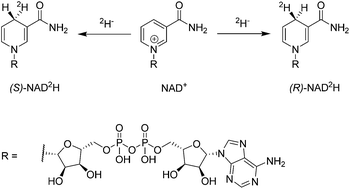
Org. Biomol. Chem., 2015,13, 357-360
https://doi.org/10.1039/C4OB02071E
A peptide topological template for the dispersion of [60]fullerene in water
Stable dispersions of [60]fullerene in water with concentrations of up to 1.3 mg mL−1 have been obtained using a peptide topological template as the carrier.
![Graphical abstract: A peptide topological template for the dispersion of [60]fullerene in water](/en/Image/Get?imageInfo.ImageType=GA&imageInfo.ImageIdentifier.ManuscriptID=C4OB02102A&imageInfo.ImageIdentifier.Year=2015)
Org. Biomol. Chem., 2015,13, 348-352
https://doi.org/10.1039/C4OB02102A
Cell-penetrating poly(disulfide)s: the dependence of activity, depolymerization kinetics and intracellular localization on their length
We report that, with the increasing length, cell-penetrating poly(disulfide)s preferably accumulate in the endosomes, cytosol and then the nucleoli.
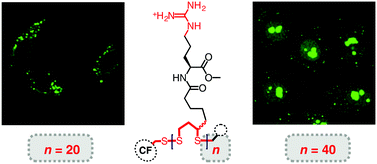
Org. Biomol. Chem., 2015,13, 64-67
https://doi.org/10.1039/C4OB02060J
Transition metal ion induced hydrogelation by amino-terpyridine ligands
Hydrogelation behavior of a new class of terpyridine based metallogelators are explored. The gelation and the gel morphology was found to be critically dependent on divalent metal ions, anions and on subtle structural changes on the gelator molecule.

Org. Biomol. Chem., 2014,12, 8836-8839
https://doi.org/10.1039/C4OB01867B
Folded alkyl chains in water-soluble capsules and cavitands
A deep cavitand with ionic “feet” dimerizes around hydrophobic compounds in D2O.
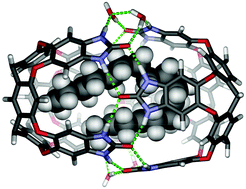
Org. Biomol. Chem., 2014,12, 6561-6563
https://doi.org/10.1039/C4OB01032A
Chelate effects in sulfate binding by amide/urea-based ligands
Chelate and mini-chelate effects on sulfate binding was explored for six amide-, amide/amine-, urea-, and urea/amine-based ligands in water-mixed DMSO-d6. The urea hosts were highly selective for SO42−, and displayed enhanced binding and greater tolerance for increasing water content as the number of chelate groups increased.
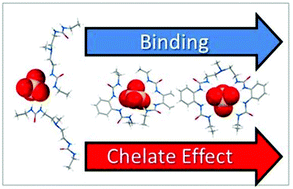
Org. Biomol. Chem., 2015,13, 6953-6957
https://doi.org/10.1039/C5OB00618J
Tri- and tetra-substituted cyclen based lanthanide(III) ion complexes as ribonuclease mimics: a study into the effect of log Ka, hydration and hydrophobicity on phosphodiester hydrolysis of the RNA-model 2-hydroxypropyl-4-nitrophenyl phosphate (HPNP)
Lanthanide(III) complexes of ‘pseudo’ dipeptide ligands and 3'-pyridine ligands have been characterised as metallo-ribonuclease mimics.

Org. Biomol. Chem., 2015,13, 5804-5816
https://doi.org/10.1039/C4OB02384F
“Off-on” aggregation-based fluorescent sensor for the detection of chloride in water
A new class of 2,6-bis(2-anilinoethynyl)pyridine bisureas exhibits selective turn-on fluorescence for chloride in water.
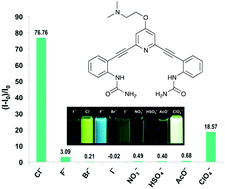
Org. Biomol. Chem., 2015,13, 4266-4270
https://doi.org/10.1039/C4OB02409E
Contributions of pocket depth and electrostatic interactions to affinity and selectivity of receptors for methylated lysine in water
Investigation of charge and pocket depth in a series of receptors led to improved affinity and selectivity for trimethyllysine.
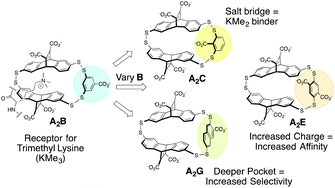
Org. Biomol. Chem., 2015,13, 3220-3226
https://doi.org/10.1039/C4OB02231A
Tuning temperature responsive poly(2-alkyl-2-oxazoline)s by supramolecular host–guest interactions
A poly[(2-ethyl-2-oxazoline)-ran-(2-nonyl-2-oxazoline)] random copolymer was synthesized and its thermoresponsive behavior in aqueous solution modulated by the addition of different supramolecular host molecules.

Org. Biomol. Chem., 2015,13, 3048-3057
https://doi.org/10.1039/C4OB02654C
Hybridization of an Aβ-specific antibody fragment with aminopyrazole-based β-sheet ligands displays striking enhancement of target affinity
A His-tagged antibody is combined with an NTA-β-sheet breaker and displays a striking increase in Aβ affinity.
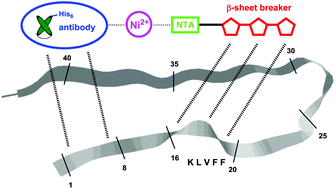
Org. Biomol. Chem., 2015,13, 2974-2979
https://doi.org/10.1039/C4OB02411G
A γ-cyclodextrin duplex connected with two disulfide bonds: synthesis, structure and inclusion complexes
Oxidative dimerization of 6I,6V-disulfanyl-γ-cyclodextrin yields a duplex tubular structure with internal volume of ∼740 Å3 allowing formation of very stable inclusion complexes with medium to large organic molecules in water (Ka ∼ 108 M−1).

Org. Biomol. Chem., 2015,13, 2980-2985
https://doi.org/10.1039/C4OB02464H
Primary amine recognition in water by a calix[6]aza-cryptand incorporated in dodecylphosphocholine micelles
A zinc calix[6]azacryptand complex was incorporated into dodecylphosphocholine micelles. This complex can strongly and selectively bind linear primary amines in an aqueous medium.
![Graphical abstract: Primary amine recognition in water by a calix[6]aza-cryptand incorporated in dodecylphosphocholine micelles](/en/Image/Get?imageInfo.ImageType=GA&imageInfo.ImageIdentifier.ManuscriptID=C4OB02495H&imageInfo.ImageIdentifier.Year=2015)
Org. Biomol. Chem., 2015,13, 2931-2938
https://doi.org/10.1039/C4OB02495H
Molecular motion of donor–acceptor catenanes in water
In this article, we use 1H NMR spectroscopy to study the spontaneous molecular motion of donor–acceptor [2]catenanes in water.

Org. Biomol. Chem., 2015,13, 2927-2930
https://doi.org/10.1039/C4OB02457E
Solvent- and phase-controlled photochirogenesis. Enantiodifferentiating photoisomerization of (Z)-cyclooctene sensitized by cyclic nigerosylnigerose-based nanosponges crosslinked by pyromellitate
The enantioselectivity of the (E)-cyclooctene produced critically depended on the solvent and also on the phase evolved, maximizing at the flowing/rigid gel border.
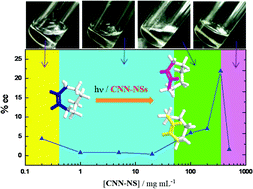
Org. Biomol. Chem., 2015,13, 2905-2912
https://doi.org/10.1039/C4OB02390K
Regulating exocytosis of nanoparticles via host–guest chemistry
Regulating exocytosis of AuNPs by using host–guest interactions between AuNPs and CB[7] molecules.
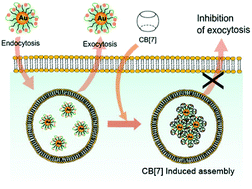
Org. Biomol. Chem., 2015,13, 2474-2479
https://doi.org/10.1039/C4OB02433H
Binding modes of a core-extended metalloporphyrin to human telomeric DNA G-quadruplexes
A novel π-extended NiII-porphyrin shows a high selectivity towards human telomeric G-quadruplexes.
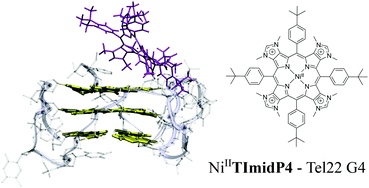
Org. Biomol. Chem., 2015,13, 2453-2463
https://doi.org/10.1039/C4OB02097A
Effect of the amino acid composition of cyclic peptides on their self-assembly in lipid bilayers
The effect of amino acid composition on the formation of transmembrane channels in lipid bilayers upon self-assembly of alt-(L,D)-α-cyclic octapeptides has been investigated.
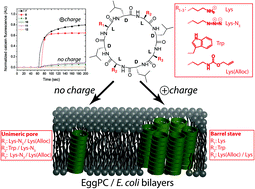
Org. Biomol. Chem., 2015,13, 2464-2473
https://doi.org/10.1039/C4OB02041C
Fluoride binding in water with the use of micellar nanodevices based on salophen complexes
Uranyl-salophen complexes incorporated into micelles are evaluated as supramolecular nanosystems for the binding of fluoride in water.
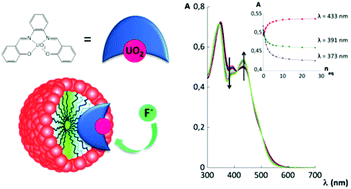
Org. Biomol. Chem., 2015,13, 2437-2443
https://doi.org/10.1039/C4OB02298J
Synthesis and physico-chemical properties of the first water soluble Cu(II)@hemicryptophane complex
A water-soluble metallo-enzyme model featuring a copper(II) site encaged in a closed-shell cavity of a hemicryptophane has been synthesized and studied.

Org. Biomol. Chem., 2015,13, 2157-2161
https://doi.org/10.1039/C4OB02085E
A coumarin based gold(I)-alkynyl complex: a new class of supramolecular hydrogelators
A phosphine-gold(I)-alkynyl-coumarin complex, [Au{7-(prop-2-ine-1-yloxy)-1-benzopyran-2-one}(DAPTA)] (1), was synthesized and the formation of long luminescent fibers in solution was characterized via fluorescence microscopy and dynamic light scattering.
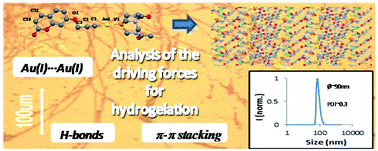
Org. Biomol. Chem., 2015,13, 2026-2033
https://doi.org/10.1039/C4OB02077D
Differentiation of small alkane and alkyl halide constitutional isomers via encapsulation
Previously we have demonstrated that host 1 is capable of hydrocarbon gas separation by selective sequestration of butane from a mixture with propane in the headspace above a solution of the host (C. L. D. Gibb, B. C. Gibb, J. Am. Chem. Soc., 2006, 128, 16498–16499).
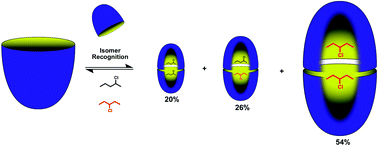
Org. Biomol. Chem., 2015,13, 1869-1877
https://doi.org/10.1039/C4OB02357A
Highly efficient stabilisation of meta-ethynylpyridine polymers with amide side chains in water by coordination of rare-earth metals
An amphiphilic meta-ethynylpyridine polymer with chiral amide side chains coordinated with rare-earth metal salts, especially strongly with Sc(III), to stabilise its helical structure with CD enhancement.
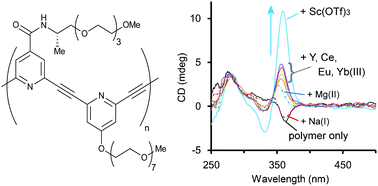
Org. Biomol. Chem., 2015,13, 1700-1707
https://doi.org/10.1039/C4OB02129K
Phosphate binding by a novel Zn(II) complex featuring a trans-1,2-diaminocyclohexane ligand. Effective anion recognition in water
Excellent affinities and selectivities toward triphosphates are achieved through an adaptive ditopic receptor featuring a metal ion and a macrocyclic polyammonium cation binding sites, concertedly bridging phosphate anions.
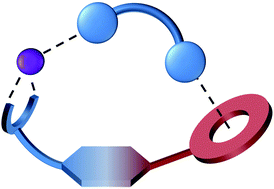
Org. Biomol. Chem., 2015,13, 1860-1868
https://doi.org/10.1039/C4OB02321H
Anion binding and transport properties of cyclic 2,6-bis(1,2,3-triazol-1-yl)pyridines
The anion binding and membrane transport properties of a series of cyclic 2,6-bis-(1,2,3-triazolyl)-pyridine receptors with thiourea functionalities are reported.
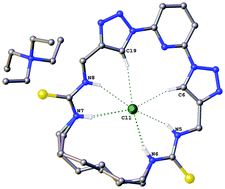
Org. Biomol. Chem., 2015,13, 1654-1661
https://doi.org/10.1039/C4OB02236J
Preparation of luminescent chemosensors by post-functionalization of vesicle surfaces
A variety of luminescent chemosensors is obtained by post-functionalization of self-assembled phospholipid vesicles with receptor units ranging from metal complexes to aptamers.
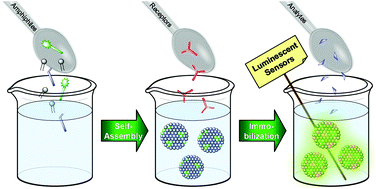
Org. Biomol. Chem., 2015,13, 1690-1699
https://doi.org/10.1039/C4OB02327G
Aryl-bis-(scorpiand)-aza receptors differentiate between nucleotide monophosphates by a combination of aromatic, hydrogen bond and electrostatic interactions
Bis-scorpiands bind nucleotides in water with 10–100 μM affinity, with selectivity: at pH 7 pyridine-scorpiand toward CMP; at pH 5 phenanthroline-scorpiand toward AMP.
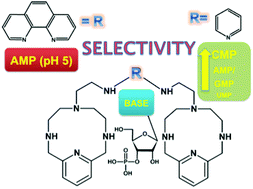
Org. Biomol. Chem., 2015,13, 1732-1740
https://doi.org/10.1039/C4OB02084G
Cyclodextrin- and calixarene-based polycationic amphiphiles as gene delivery systems: a structure–activity relationship study
Multi-head/multi-tail facial amphiphiles built on cyclodextrin (CD) and calixarene (CA) scaffolds are paradigmatic examples of monodisperse gene delivery systems.
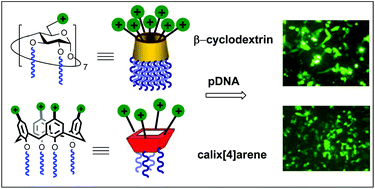
Org. Biomol. Chem., 2015,13, 1708-1723
https://doi.org/10.1039/C4OB02204A
UV-visible and 1H–15N NMR spectroscopic studies of colorimetric thiosemicarbazide anion sensors
Four model thiosemicarbazide anion chemosensors containing three N–H bonds, substituted with phenyl and/or 4-nitrophenyl units, were synthesised and studied for their anion binding abilities with hydroxide, fluoride, acetate, dihydrogen phosphate and chloride.
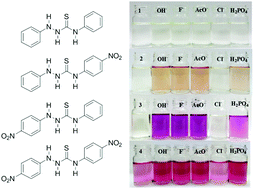
Org. Biomol. Chem., 2015,13, 1662-1672
https://doi.org/10.1039/C4OB02091J
Computational study on the intramolecular self-organization of the macrorings of some ‘giant’ cyclodextrins (CDn, n = 40, 70, 85, 100)
A limited number of modes determine the overall deformations of the macrorings, which may have more than one cavity. Accordingly, they have the potential to accommodate more than one substrate molecule.
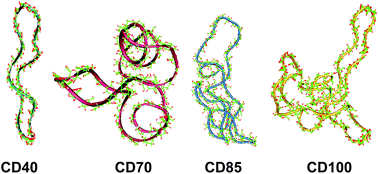
Org. Biomol. Chem., 2015,13, 1680-1689
https://doi.org/10.1039/C4OB02218A
The aqueous medium-dimethylsulfoxide conundrum in biological studies
A series of straight and branched chain pyrogallol[4]arenes was studied and found to be essentially nontoxic to two strains of E. coli.
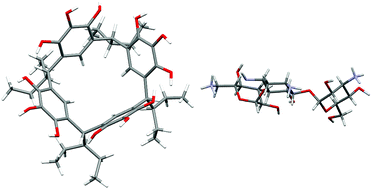
RSC Adv., 2015,5, 8088-8093
https://doi.org/10.1039/C4RA15217D
Water-soluble aryl-extended calix[4]pyrroles with unperturbed aromatic cavities: synthesis and binding studies
An aryl-extended calix[4]pyrrole receptor with four carboxylic groups at the lower rim binds N-oxides in water with high stability constants.
![Graphical abstract: Water-soluble aryl-extended calix[4]pyrroles with unperturbed aromatic cavities: synthesis and binding studies](/en/Image/Get?imageInfo.ImageType=GA&imageInfo.ImageIdentifier.ManuscriptID=C4OB02108H&imageInfo.ImageIdentifier.Year=2015)
Org. Biomol. Chem., 2015,13, 1022-1029
https://doi.org/10.1039/C4OB02108H
Probing coiled-coil assembly by paramagnetic NMR spectroscopy
Here a new method to determine the orientation of coiled-coil peptide motifs is described.

Org. Biomol. Chem., 2015,13, 1159-1168
https://doi.org/10.1039/C4OB02125H
Label-free fluorescence detection of kinase activity using a gold nanoparticle based indicator displacement assay
A straightforward fluorescence indicator-displacement assay (IDA) has been developed for the quantitative analysis of ATP→ADP conversion.
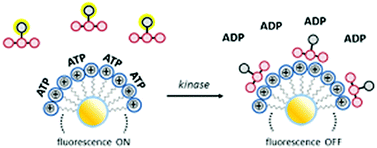
Org. Biomol. Chem., 2015,13, 1198-1203
https://doi.org/10.1039/C4OB02052A
Tuning the pH-triggered self-assembly of dendritic peptide amphiphiles using fluorinated side chains
We report the synthesis of a series of anionic dendritic peptide amphiphiles of increasing hydrophobic character and describe their self-assembly into supramolecular nanorods using pH and ionic strength dependent state diagrams.

Org. Biomol. Chem., 2015,13, 1030-1039
https://doi.org/10.1039/C4OB02185A
Interactions of arene ruthenium metallaprisms with human proteins
Interactions between three hexacationic arene ruthenium metallaprisms and human proteins have been studied using NMR spectroscopy, mass spectrometry and circular dichroism spectroscopy, showing that proteins are potential biological targets for these metallaprisms.
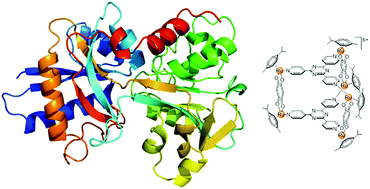
Org. Biomol. Chem., 2015,13, 946-953
https://doi.org/10.1039/C4OB02194K
A thermodynamic insight into the recognition of hydrophilic and hydrophobic amino acids in pure water by aza-scorpiand type receptors
Thermodynamic studies about the interaction of scorpiand aza-macrocycles with amino acids in water show entropy driven stabilisations often associated with solvation/desolvation processes.
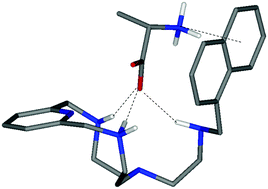
Org. Biomol. Chem., 2015,13, 843-850
https://doi.org/10.1039/C4OB02092H
pH response and molecular recognition in a low molecular weight peptide hydrogel
The preparation and characterization of a tripeptide based hydrogel, which possesses characteristic rheological properties, is pH responsive and can be functionalized at its thiol function is reported.
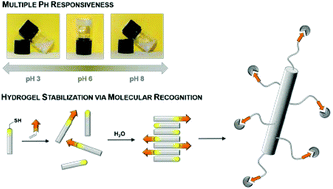
Org. Biomol. Chem., 2015,13, 561-569
https://doi.org/10.1039/C4OB02069C
Selective detection of Al3+ and citric acid with a fluorescent amphiphile
The assembly and disassembly of a fluorescent amphiphile by Al3+ and citrate, respectively, can be used to sense these analytes by fluorescence spectroscopy.
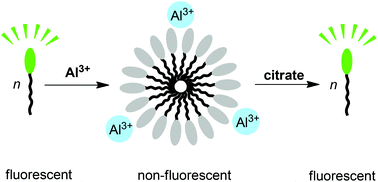
Org. Biomol. Chem., 2015,13, 252-257
https://doi.org/10.1039/C4OB02095B
Multivalent helix mimetics for PPI-inhibition
A multivalent helix mimetic is developed that inhibits the p53/hDM2 and induces dimerization/aggregation of its target – hDM2.
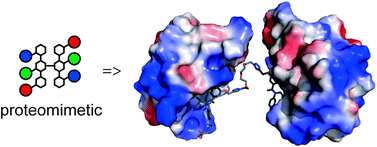
Org. Biomol. Chem., 2015,13, 258-264
https://doi.org/10.1039/C4OB02066A
Anion binding of a neutral bis(cyclopeptide) in water–methanol mixtures containing up to 95% water
Selectivity of a synthetic anion receptor reverses from strongly coordinating sulfate to weakly coordinating iodide anions upon increasing the water content of the solution.
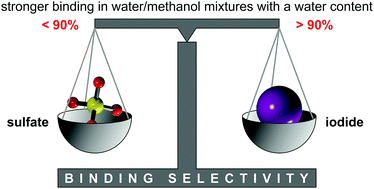
Org. Biomol. Chem., 2014,12, 8851-8860
https://doi.org/10.1039/C4OB01497A
Influence of B-ring modifications on proton affinity, transmembrane anion transport and anti-cancer properties of synthetic prodigiosenes
We describe how modulating the pKa of a family of synthetic prodigiosenes, modified on their B-ring, can control the transmembrane transport of anions.

Org. Biomol. Chem., 2014,12, 7515-7522
https://doi.org/10.1039/C4OB01399A
Development and mechanistic studies of an optimized receptor for trimethyllysine using iterative redesign by dynamic combinatorial chemistry
Iterative monomer redesign leads to a Kme3-peptide receptor with 10-fold tighter affinity and 5-fold improved selectivity over Kme2 than the original receptor. Thermodynamic analysis provides insight into this improvement.
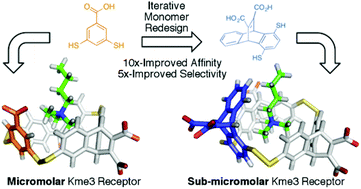
Org. Biomol. Chem., 2014,12, 7059-7067
https://doi.org/10.1039/C4OB01249F
Diguanidinocalix[4]arenes as effective and selective catalysts of the cleavage of diribonucleoside monophosphates
Upper rim diguanidino-cone-calix[4]arenes catalyze the hydrolytic cleavage of diribonucleoside monophosphates in aqueous DMSO with good substrate selectivity and rate accelerations approaching 105-fold in the most favourable substrate-catalyst combinations.
![Graphical abstract: Diguanidinocalix[4]arenes as effective and selective catalysts of the cleavage of diribonucleoside monophosphates](/en/Image/Get?imageInfo.ImageType=GA&imageInfo.ImageIdentifier.ManuscriptID=C4RA05751A&imageInfo.ImageIdentifier.Year=2014)
RSC Adv., 2014,4, 34412-34416
https://doi.org/10.1039/C4RA05751A
Enhanced catalysis and enantioselective resolution of racemic naproxen methyl ester by lipase encapsulated within iron oxide nanoparticles coated with calix[8]arene valeric acid complexes
In this study, two types of nanoparticles have been used as additives for the encapsulation of Candida rugosa lipase via the sol–gel method.
![Graphical abstract: Enhanced catalysis and enantioselective resolution of racemic naproxen methyl ester by lipase encapsulated within iron oxide nanoparticles coated with calix[8]arene valeric acid complexes](/en/Image/Get?imageInfo.ImageType=GA&imageInfo.ImageIdentifier.ManuscriptID=C4OB01048E&imageInfo.ImageIdentifier.Year=2014)
Org. Biomol. Chem., 2014,12, 6634-6642
https://doi.org/10.1039/C4OB01048E
Selective recognition of anionic cell membranes using targeted liposomes coated with zinc(II)-bis(dipicolylamine) affinity units
Liposomes containing phospholipid-PEG conjugates with terminal zinc(ıı)-bis(dipicolylamine) affinity units selectively target anionic membrane surfaces including the exterior of bacterial and dead/dying mammalian cells.
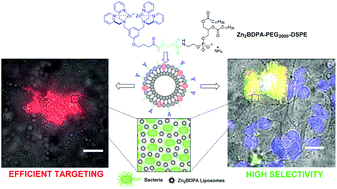
Org. Biomol. Chem., 2014,12, 5645-5655
https://doi.org/10.1039/C4OB00924J
B-DNA structure and stability: the role of hydrogen bonding, π–π stacking interactions, twist-angle, and solvation
Insight into structure and stability of B-DNA is obtained through systematic quantum chemical analyses of the roles played by hydrogen bonding, π–π stacking, solvation, and twist-angle.

Org. Biomol. Chem., 2014,12, 4691-4700
https://doi.org/10.1039/C4OB00427B
About this collection
This themed collection published in Organic & Biomolecular Chemistry (OBC) highlights some of the latest exciting research in Supramolecular Chemistry in Water. The issue is Guest Edited by Professors Tony Davis (University of Bristol, United Kingdom), Antonella Dalla Cort (Università La Sapienza, Italy), and Stefan Kubik (Technische Universität Kaiserslautern, Germany). New articles will be added to this collection as they are published.
A convenient short url for this collection isrsc.li/ob-h2o-supramol-chem